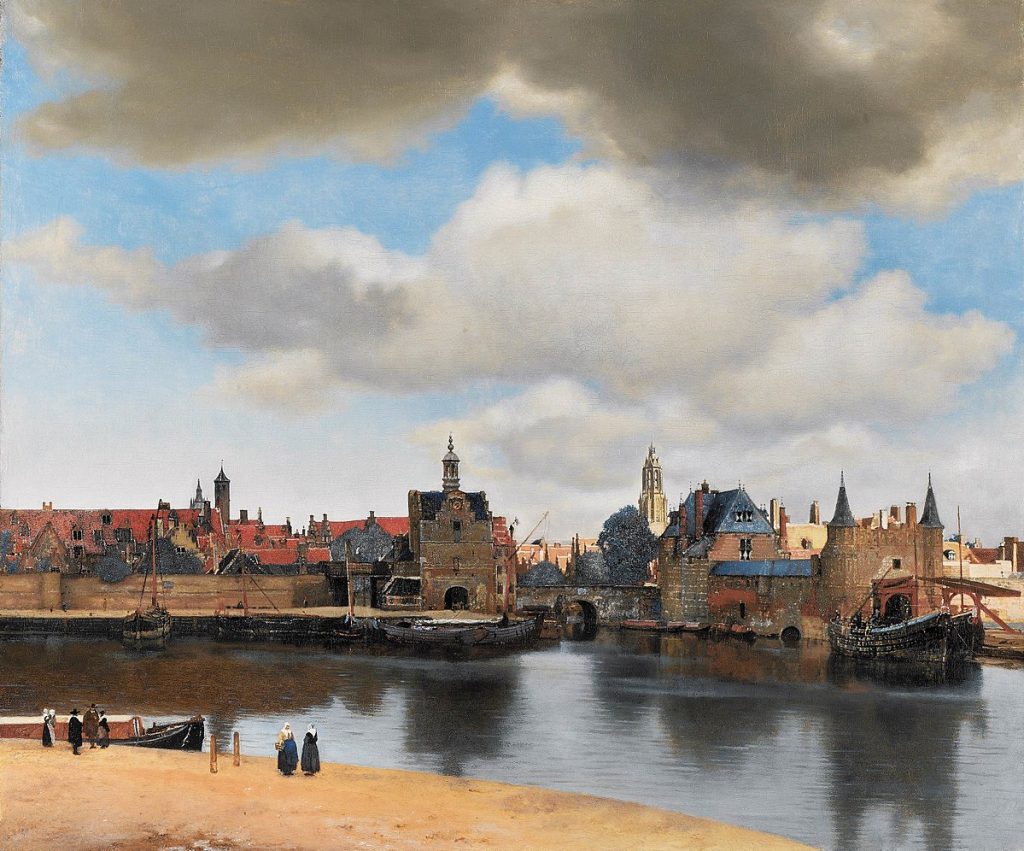
Johannes Vermeer, View of Delft, c. 1660–1661, Mauritshuis, The Hague, Netherlands.
Who Was Maria de Knuijt?
Maria Simonsdr de Knuijt was a citizen of Delft, married to Pieter Claesz van Ruijven, the son of a wealthy brewer. The couple owned houses on the Oude Delft canal and Voorstraat in Delft and acquired a majority of Vermeer’s oeuvre; that is 21 paintings later inherited by their daughter Magdalena and her husband Jacob Dissius. Among the works were: A Maid Asleep, Cavalier and a Young Woman, The Milkmaid, Girl with a Pearl Earring, The Guitar Player, The Lacemaker, The Little Street, and View of Delft – as well as many others.

Johannes Vermeer, The Little Street, c. 1657–1658, Rijksmuseum, Amsterdam, Netherlands.
Although in the literature on Vermeer, it is repeated that Van Ruijven played an active part in collecting the artist’s works, it was de Knuijt who had a much closer relationship with the Vermeer family. She grew up just a few doors away from the Vermeers’ house called Mechelen. It seems reasonable to assume that she saw the young Johannes, and then his children, grow up on the same street.

Johannes Vermeer, The Milkmaid, 1657–1658, Rijksmuseum, Amsterdam, Netherlands.
As mentioned earlier, art historians believe both de Knuijt and Van Ruijven were the main patrons of Johannes Vermeer. However, we must consider that in Vermeer’s time, paintings were viewed as household goods and thus it was the lady of the house who was responsible for furnishing, decorating, and purchasing artworks.
Maria de Knuijt’s importance to Vermeer’s career came to the light only recently thanks to archival research drawing attention to her personal will from 1665. In the document we learn that she bequeathed 500 guilders to Vermeer – most likely the sum is related to the delivery of paintings. Interestingly, the artist was the only beneficiary outside of her family.

Johannes Vermeer, A Maid Asleep, c. 1657, The Metropolitan Museum of Art, New York, NY, USA.
De Knuijt died in February 1681, seven years after her husband. The couple’s estate was inherited by their daughter Magdalena who unfortunately died in 1682, presumably in childbirth. Her husband, Jacos Dissius, drew up an inventory of the estate of his late wife in 1683 in which ca. 20 paintings by Vermeer were recorded. The works were eventually sold at an auction in Amsterdam a few months later.
New View on Vermeer’s Women
“The contrast between Vermeer’s four surviving early works and his globally celebrated mature paintings is stark,” we read in the exhibition catalog. Vermeer’s earliest paintings are large in format and depict so-called history scenes deriving from the Bible or mythology. Those paintings are Christ in the House of Mary and Martha, Saint Praxedis, Diana and Her Nymphs, and The Procuress painted between 1654 and 1656.

Johannes Vermeer, Christ in the House of Martha and Mary, c. 1655, Scottish National Gallery, Edinburgh, UK.
These four works are a testament to Vermeer’s early ambition to become a history painter, but around 1656/1657 the subject matter of his paintings suddenly changed. In the years following the execution of The Procuress, Vermeer began to paint on a much smaller and more intimate scale, depicting genre scenes with household interiors and featuring either young women or couples. Many art historians believe that this change occurred during Pieter van Ruijven’s patronage but in the exhibition catalog, we learn that Maria de Knuijt might have played a bigger role in Vermeer’s choice of motifs.

Johannes Vermeer, The Procuress, 1656, Gemäldegalerie Alte Meister, Dresden, Germany.
For years it was believed that women merely played a passive role in Vermeer’s career as models, anonymous figures, longing wives, idle housemaids, and naïve girls easily manipulated by their worldly male companions. Thanks to the ongoing efforts of many scholars, we are finally beginning to acknowledge the presence of women artists and patrons. Johannes Vermeer was an artist surrounded by strong women who supported him. It was not only Maria de Knuijt but also his wife, Catharina Bolnes, and his mother-in-law, Maria Thins, two women of greater financial means than Vermeer, who played an important role in preserving his legacy after his death.

Johannes Vermeer, Girl Reading a Letter at an Open Window, ca. 1657–1659, Gemäldegalerie Alte Meister, Staatliche Kunstsammlungen Dresden, Germany.
About the Exhibition
If you missed the Vermeer exhibition in the Rijksmuseum, don’t worry! You can explore the showcased works in detail on the museum website!
